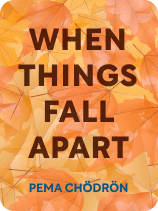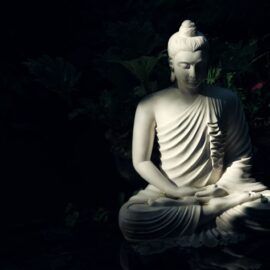

This article is an excerpt from the Shortform book guide to "When Things Fall Apart" by Pema Chödrön. Shortform has the world's best summaries and analyses of books you should be reading.
Like this article? Sign up for a free trial here.
Are you stuck in a state of uncertainty and suffering? What’s When Things Fall Apart by Pema Chödrön about?
In When Things Fall Apart, Pema Chödrön provides guidance on how to find courage and compassion amid pain, loss, and uncertainty. She shows us how to cultivate self-awareness and acceptance and face life’s challenges with grace and resilience.
Read below for an overview of Pema Chödrön’s self-improvement book When Things Fall Apart.
When Things Fall Apart by Pema Chödrön
Life naturally cycles through easy, enjoyable times and difficult, painful times. When life becomes challenging—when we endure significant losses, grapple with conflict, and witness our loved ones suffer—it can feel overwhelming, disorienting, and unfair.
In When Things Fall Apart, Pema Chödrön argues that pain and suffering are inevitable parts of life but that these experiences can also be opportunities for growth and transformation. She draws on ancient Buddhist wisdom and practices to offer a path through life’s most challenging moments, writing that when things feel unbearably difficult, we can navigate them by staying in the present moment, cultivating compassion for ourselves and others, facing our fears, and accepting reality as it is.
Pema Chödrön is an American-Tibetan Buddhist nun who studied under the Tibetan Buddhist meditation master, Chögyam Trungpa. She is a teacher, public speaker, and author of 20 books on Buddhism and mindfulness, including How to Meditate: A Practice Guide to Making Friends with Your Mind. In her teachings, she stresses the importance of embracing our experiences, rather than trying to avoid them or escape them, as a way to cultivate inner strength and resilience.
Why We Suffer
Navigating hardship, loss, and uncertainty is something we all must do at some point in our lives. Many things can fall apart with or without notice—our images of ourselves, our beliefs, our health or the health of a loved one, important relationships, and so on. When things change for the worse, we can become overwhelmed by negative emotions like worry, doubt, anger, fear, and despair.
Challenging times may be inevitable, but is it inevitable that we suffer because of them? Chödrön argues no. She explains that we suffer because the strong beliefs we hold are in conflict with reality.
The incorrect beliefs we hold that make difficult times so painful include the following:
False Belief #1: Suffering Is Unacceptable and Should Not Exist
We believe the presence of suffering is unnatural and unacceptable and it signals that there’s something wrong with us and the world. Therefore, we’re convinced that emotional discomfort and pain should be avoided and fixed. Our most overwhelming and painful emotions can feel like personal demons that come in many shapes and sizes—fear, shame, jealousy, rage, loneliness, and the need to place blame.
However, Chödrön explains the Buddhist teaching that suffering is an innate part of life—all living beings on the planet experience pain, loss, confusion, sickness, and death. Emotional discomfort and pain are natural and inevitable, and they aren’t a sign that anything is going wrong. Because we’re not taught to accept suffering and difficult emotions as a natural part of reality, we resist suffering and put tremendous effort into avoiding it, denying it, and trying to fix it. In doing so, we miss out on the beauty and joy of life.
False Belief # 2: We Can Achieve Lasting Security
We believe that if we do all the right things—work, plan, and pray hard enough—we can achieve lasting security, consistency, and predictability in our lives. We feel that what we have and who we are right now are not good enough and that contentment and safety are always just around the corner.
However, Chödrön explains that clinging to the hope that circumstances will last is the root cause of suffering, according to Buddhist teachings. In reality, nothing lasts forever—life is inherently uncertain and always changing. Chödrön says we live in denial of the fundamental uncertainty and insecurity of life, and when we’re confronted with our lack of control, we try to escape the discomfort by avoiding pain and seeking pleasure. In doing so, we inevitably become frustrated, disappointed, and exhausted because we are working against the nature of reality.
How to Ease Suffering and Navigate Difficult Times
Chödrön writes that the key to getting through difficult times with less suffering is to let go of the idea that there’s a cure for pain and uncertainty and recognize these are constant and ever-present parts of life—you will experience constant change, and to live fully, you must stop trying to make things permanently ideal. Learn to relax and accept the instability and the fundamental uncertainty of being alive.
Chödrön also writes that you can turn negative experiences into opportunities for growth. Doing this can help you cultivate more inner peace, which benefits you, those around you, and the whole planet.
You can let go of unhelpful beliefs, relax, and remain steady amidst chaos by learning to stay in the present moment. Chödrön explains that in the present moment, we can drop the painful and unhelpful stories we tell ourselves about who we are, what is happening to us, and what is true about the world. In this state, we can experience more courage, strength, and appreciation for reality. And we can live more fully without constantly seeking pleasure and striving to avoid and eliminate pain.
According to Chödrön, you can develop the ability to stay present by learning and following the teachings of Buddhism: practicing meditation and mindfulness, cultivating compassion for yourself and others, turning towards fear and releasing hope, and accepting reality as it is.
Practice Meditation and Mindfulness
Chödrön asserts that cultivating mindfulness through meditation is the first step in learning how to cope with difficult times. It also allows you to use painful experiences as catalysts for experiencing peace in your life.
In meditation, practice being with your experience in the present moment—whether it’s painful, enjoyable, or a mix of both—and accepting it. Notice without judgment whatever thoughts and feelings come up, then let them go and return to the present moment. The purpose of meditation is not to rid yourself of unpleasant thoughts or feelings, which is impossible. Because mindfulness leads to clarity and spaciousness around your thoughts and feelings, it helps you to not get swept away by your hopes and fears in hard times.
Additionally, you can see your habit of escaping certain emotions because you’re paying attention to your experience. You can then develop the ability to let your emotions be present without indulging them or repressing them. Chödrön explains that this mindful awareness can translate into your daily life if you practice meditation regularly. You’ll develop inner acceptance and peace, despite how your outer life may look.
Chödrön teaches that only the present moment is real—the past and future are illusions. We all think about the past and future to escape the discomfort of everything we don’t know and can’t control. Therefore, as you learn to be more present, you may feel vulnerable because you have nowhere to escape to mentally. And Chödrön explains that when you have nowhere to hide from reality, your heart will open more fully to yourself, others, and the world.
Cultivate Compassion For Yourself and Others
Chödrön teaches that one of the most powerful ways to stay afloat during difficult times and transform your pain into a positive force is to cultivate compassion for yourself and others. In Tibetan Buddhism, the path of cultivating compassion for yourself is called maitri, which translates from Sanskrit to loving-kindness. By practicing maitri, you can make friends with yourself—trust and lean on yourself—and feel more connection to and belonging with others.
Turn Toward Fear and Let Go of Hope
Chödrön writes that it’s impossible to be liberated from fear without turning toward it, experiencing it fully, and letting go of hope for an ideal life. Avoiding or covering up any negative emotion, including fear, only strengthens it. And grasping onto hope for something better only makes us resist reality.
As you grapple with difficulty and uncertainty, you will inevitably experience longing for things to improve and fear that things will not improve or even worsen. One way to have a relationship with fear is to pause before you distract yourself from it or try to fix it. Instead, become familiar with how fear feels and don’t try to change it. Letting yourself feel your fear is an opportunity to learn more about yourself, become your own friend, be humble, and tap into your courage.
According to Chödrön, turning toward fear is helpful but not enough. To find true freedom from fear, you must rethink hope and let it go. She explains that hope—carrying a desire and vision for something better—can be just as detrimental to peace as fear because it keeps you from accepting reality and living in the present moment, where you can find all your wisdom and strength. Holding onto hope sets you up for disappointment and more suffering. However, when you release hope that pain and insecurity can be eliminated from your life, you’ll stop trying to achieve lasting security and comfort (which is unattainable) and gain the confidence to relax and accept uncertainty.
We tend to see hope as the antidote to fear. But Chödrön explains the people of Tibet see fear and hope as two sides of the same coin: They understand that the fear of loss and pain comes from having hope that circumstances can be ideal. The root of hope and fear are the false beliefs we have about reality—we feel we lack something, things are going wrong, suffering is unacceptable, and someone or something is to blame.
Cultivating mindfulness and compassion can help you turn toward fear and release hope. To build compassion for yourself and better understand your emotional responses, accept that fear and hope are natural responses to suffering. When we go through hard times, Chödrön believes there is an enormous possibility for renewal and positive change, but we overlook the potential in hardship because we are too attached to our false beliefs about suffering. Cultivate mindfulness and compassion and you will gain confidence in your ability to embrace reality with acceptance.
Accept Reality as It Is
Chödrön’s final recommendation for coping more gracefully with difficulty is to accept reality as it is. When you stop resisting reality, you can relax and accept whatever is happening in your life and experience more peace, even if your circumstances are painful and stressful.
Chödrön says to accept reality, you must acknowledge the limited knowledge and control you have in life. In doing so, you can accept the present moment as it is without trying to predict or control the future. Our minds confidently develop inaccurate ideas about ourselves and reality all the time, and we tend to cling to our ideas, even when they’re negative because they provide us with a sense of familiarity and security. However, this sense of security is false, as everything, including ourselves, is in a constant state of change. Chödrön explains that when you accept how little you know about the present and future, you open more to the possibility that your challenging circumstances may have a positive outcome that you can’t yet imagine.
Develop a regular meditation practice and practice mindfulness in your daily life to learn how to stop resisting reality and fighting with yourself and your circumstances. Every time you acknowledge your thoughts, let them go, and return your attention to your breath, you’re strengthening your ability to compassionately accept yourself and reality. Chödrön argues that there is nothing so big or overwhelming that mindfulness and compassion can’t help.

———End of Preview———
Like what you just read? Read the rest of the world's best book summary and analysis of Pema Chödrön's "When Things Fall Apart" at Shortform.
Here's what you'll find in our full When Things Fall Apart summary:
- How to find courage and compassion amid pain, loss, and uncertainty
- How to use pain and suffering to grow and transform your life
- Buddhist methods for easing suffering and finding inner peace






